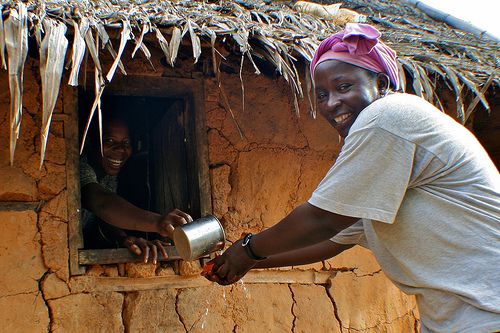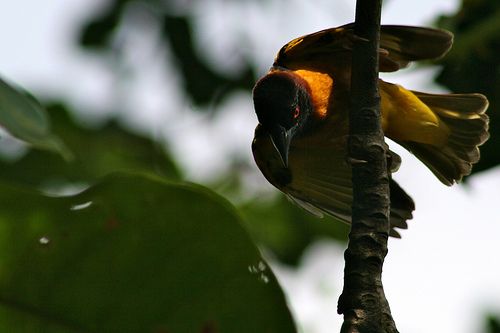Vulnerability, forest-related sectors and climate change adaptation: The case of Cameroon

In Cameroon and elsewhere in the Congo Basin, the majority of rural households and a large proportion of urban households depend on plant and animal products from the forests to meet their nutritional, energy, cultural and medicinal needs. Climate change and other pressures will influence the provisioning of forest ecosystem goods and services, with subsequent negative effects on the economic and social well-being of the society, including the national economy and the livelihoods of forest-dependent people.
During periods of crop failures especially in agricultural communities, forest foods are most extensively used to help meet dietary shortfalls. Firewood and charcoal provide fuel for the vast majority of the people, and also provide an important source of income. The forest also provides medicines for a large proportion of urban and rural people and these medicines are one of the most valued forest products by local people. A study around Cameroon’s Mbalmayo forest reserve found that over 70% of the population depended on herbal medicines, and that these were 50–90% cheaper than pharmaceutical equivalents. Pharmaceutical uses of NTFPs generate the most significant revenues. Extracts from the bark of the Pausinystalia yohimbe (popularly known in Cameroon as the African viagra), are consumed locally as a cure for many ailments and are sold in North America and Europe as an aphrodisiac and a stimulant in soft drinks. Similarly, the bark of Prunus Africana is used to extract a chemical cocktail for the treatment of benign prostate hyperplasia in the West.
Forests are also important for national economic sectors. The contribution of the forestry sector to gross domestic product (GDP) is about 6–10% and the value of forest products (logs, sawnwood, plywood, veneers, parquets) run into millions of dollars annually. The Cameroonian forestry sector alone employs up to 13,000 people and many more within the informal sector involved in domestic timber trade, charcoal, and even NTFPs.
Clearly, any negative impacts on Cameroon’s forest resources will lead to adverse consequences for the well-being of many people.

Daily life in Cameroon. Photo by Terry Sunderland/CIFOR.
Climate change presents a risk to the composition, health, and vitality of forest ecosystems. The vulnerability of the forest ecosystems is not just related to the direct and indirect impacts of climate variability and change. Given the complex interrelations that exist between natural and human systems, impacts on one system will affect the other systems, in the same light; the vulnerability of one system could potentially lead to the vulnerability of other systems. For instance, weak and unstable rural livelihoods and factors of susceptibility that underpin people’s daily lives can lead to unsustainable local practices and systems of forest use and management, which in turn will lead to the vulnerability of the forest ecosystems (natural systems).
The implication of changing patterns of rainfall and temperature (the two most important climate variables) on the forest sector in Cameroon is twofold: firstly, resultant significant reduction in agricultural yields that contribute to the food security of the rural populations means that forest resources that can offer similar food security would be in high demand. Predicted alterations in forest landscape and biodiversity due to climate change pose a possibility of reduced access to forest products, consumed as foods.
The sensitivity and resilience of the Cameroonian forest in providing food products are nested in the domains of climate variability impacts and socio-cultural interactions of the people. The growing demands for timber products, persistence of detrimental forest logging practices, result in liquidation of timber stocks and degradation of forests. This wanes the resilience of the forest ecosystem towards climate variability factors.
In an attempt to seek alternatives to food products from the forests coupled with an increasing pressure on the forest for conversion to agricultural lands, its adaptive capacity to climate variability is influenced negatively. The ability of the forest ecosystem to accommodate climate variability diminishes, which will make the forest unable to cope with climate variations of small magnitude.
Of similar concern is the significant increase in demand for fuelwood as incomes plunge with the economic crisis and as prices of traded fuels increase. A survey of fuelwood consumption among urban households in the Center and South Provinces of Cameroon found 48% and 71% of the households, respectively, citing it as their principal cooking fuel, compared to 30% and 55% in 1987. Fuelwood is also a valuable source of income for many communities.
One possible consequence could be that where there is little or no more deadwoods to collect from the forests, samplings, young and matured trees could be harvested and dried for fuelwood. With wood harvesting or extraction rate being faster than regeneration and growth rates, the ecological functioning of the forest would be distorted on one hand, and deforestation and degradation would increase on the other. Contextualizing the exposure of this sector to climate change, temperature rise exposes the fuel wood to possibilities of forest fires. Commercialization of this sector to meet the increasing demands for fuel wood can significantly drive deforestation.

Wildlife in the Cameroonian forests. Photo by Terry Sunderland/CIFOR.
There are many human-induced pressures on forest ecosystems other than climate change, and climate change is projected to intensify them and/or exacerbate their negative effects. Such pressures threaten not just the ecosystem goods but also the services that, one hand, sustain these goods (e.g. water) and on another hand, sustain the collective well being of the human population. In the case of freshwater, forest ecosystem services such as hydrological regulation and water quality will be affected through the impact of these human-induced pressures, and the increase in population of this region due to north–south migration will amplify the effects. The resulting consequence could be severe for the forests’ capacity to provide adequate water resources for agriculture, public health, etc. Water and water management will have an implication on other sectors such as health, agriculture and energy. This is a reality in forest landscape.
The linkages between forests and different sectors and the vulnerability feedback loops underline the need of multidisciplinary and multi-institutional response to face climate change. Collaboration between sectors and institutions needs to be promoted at different scales. Vulnerability to climate impacts in the forest sector is quite related to the vulnerability of other related sectors, for example, agriculture.
Reducing vulnerability and increasing adaptive capacity become the core of the necessary adaptation strategies of the forest sector. At the political level, Cameroon has recognized the need to reduce poverty which indirectly can lead to the increase of adaptive capacity. As long as poverty remains the salient factor influencing many activities and practices of rural populations towards sustaining their livelihoods, reducing poverty should pervade all adaptation strategies and policy options. At the ecosystem level, an uninterrupted provisioning and functioning of the forest can offer structural defense against some climate impacts such as flooding, drought, etc. As the forest needs of the people would increase with increasing population, access to NTFPs should be supported by local and national policies and programs. Local participation in conservation and development efforts are inevitably intricate to the success of any adaptation strategy. Forest management and conservation practices may help to decrease the vulnerability of the social system, while at the same time maintaining the mitigation capacity of the forests. As the country is interested in the REDD mechanism, an obvious fact is that any REDD scheme that does not integrate adaptation in its design and implementation is not likely to produce the desired outcome. Despite the uncertainty surrounding the magnitude and frequency of the climate impacts the forest is exposed to, proactive adaptation of the Cameroonian forest sector could enhance the forest’s resilience to new conditions or stresses apart from the current and potential climate impacts.
Local and national adaptive capacities to respond to climate impacts in the forest sectors includes: reducing poverty, enhancing food security, water availability, combating land degradation and reducing loss of biological diversity.
The above text presents highlights from the paper by Sonwa et al. (2012) “Vulnerability, forest-related sectors and climate change adaptation: The case of Cameroon”, published in Forest Policy and Economics. The paper presents some of the adaptation research results from the Congo Basin Forest and Climate Change Adaptation project (CoFCCA), funded by the Canadian International Development Research Center (IDRC) and DFID (UK).
(0) Comments
There is no content